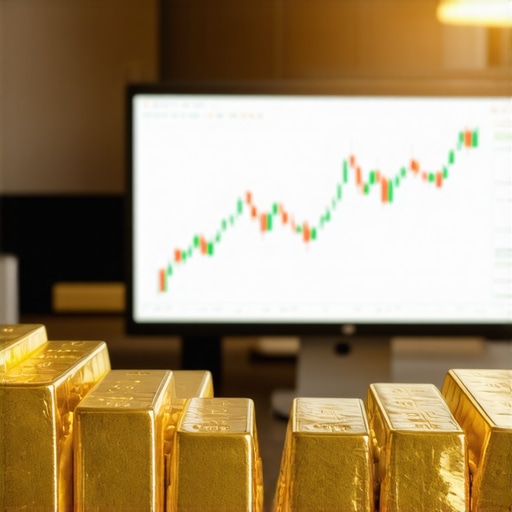Unraveling the Complex Dynamics of Gold Price Drivers in 2024: An Expert Analysis
As global financial markets navigate an era marked by economic uncertainty and technological evolution, understanding the nuanced factors influencing gold prices in 2024 is crucial for sophisticated investors and industry analysts. This comprehensive analysis explores how supply-demand mechanics, macroeconomic policies, and geopolitical tensions intertwine to shape gold’s valuation, emphasizing the importance of deep market insight and strategic foresight.
Supply-Side Variables: Mining Output, Central Bank Reserves, and Technological Disruptions
How do fluctuations in mine production and central bank gold reserves influence price stability?
Gold supply is inherently limited, with annual mine output and central bank reserves acting as pivotal levers. Recent trends indicate a slowdown in mine production due to geopolitical and environmental challenges, which constrains supply and potentially elevates prices. Simultaneously, central banks’ gold reserve management, influenced by monetary policy shifts, significantly impacts market liquidity and investor confidence. For instance, increased accumulation by central banks during geopolitical crises often correlates with upward price momentum, reflecting a strategic hedge against economic volatility.
Demand Dynamics: Jewelry, Industry, and Investment Flows
What role does technological innovation play in altering demand patterns for gold in 2024?
While traditional demand sources such as jewelry and industrial usage remain influential, technological advancements—particularly in electronics and renewable energy sectors—are catalyzing new demand channels. The surge in demand for gold in high-tech applications underscores its strategic industrial importance, which, combined with investor appetite for safe havens, creates a complex demand landscape. Monitoring shifts in consumer and industrial needs is essential for predicting price trajectories.
Economic and Geopolitical Catalysts: Inflation, Currency Fluctuations, and Policy Interventions
How do macroeconomic policies and geopolitical tensions serve as catalysts for gold price volatility?
In 2024, inflationary pressures and currency devaluations continue to drive investor interest in gold as a hedge. Central bank policies, including interest rate adjustments and quantitative easing, further influence gold’s appeal. Geopolitical tensions, especially in regions with strategic mineral resources, exacerbate market uncertainty, prompting safe-haven flows into gold. The interplay of these factors underscores the importance of macroeconomic and geopolitical literacy for market participants.
Expert Insights and Future Outlook
Experts suggest that the confluence of constrained supply, evolving demand, and macroeconomic instability will sustain gold’s bullish trend in 2024. Strategic investors are advised to diversify across physical bullion, ETFs, and mining equities, balancing immediate liquidity needs with long-term growth potential. For a deeper understanding, explore our comprehensive forecast of gold drivers for 2025.
As the landscape continues to evolve, maintaining an analytical edge and staying informed about central bank policies and technological impacts is vital. Engage with industry professionals and contribute your insights to refine investment strategies amidst this dynamic environment.
Advanced Market Indicators: Leveraging Data Analytics for Gold Price Predictions
In the rapidly evolving landscape of gold investments, relying solely on traditional indicators may no longer suffice. Modern data analytics, including machine learning models and big data integration, offer unprecedented insights into market trends. These tools analyze vast quantities of economic, geopolitical, and industry-specific data to generate predictive models that can forecast short-term and long-term price movements with higher accuracy.
Can predictive analytics transform gold investment strategies in 2024 and beyond?
Absolutely. By integrating real-time data sources such as social media sentiment, global trade flows, and macroeconomic indicators, investors can anticipate market shifts more effectively. For instance, advanced analytics can identify emerging demand patterns in technology sectors or detect early signs of central bank accumulation, providing a strategic edge. For an in-depth understanding of how these techniques complement traditional analysis, explore our comprehensive guide to gold trading techniques.
Challenging Assumptions: Is Gold Truly a Reliable Hedge in 2024?
While gold has historically been viewed as a safe haven during economic downturns, recent trends suggest a more nuanced role. Factors such as technological innovation reducing industrial demand, and the increasing prominence of digital assets competing for investor interest, challenge the conventional wisdom. Moreover, some experts argue that during certain macroeconomic environments, gold may underperform compared to equities or cryptocurrencies.
Therefore, it is crucial to question whether gold remains the optimal hedge, or if diversification into other assets like gold mutual funds or thematic ETFs might provide better risk-adjusted returns. To explore diversified investment options, consider reading our guide on building a diversified gold investment portfolio.
Expert Insights: The Role of Central Banks and Geopolitics in Shaping Gold Prices
Central banks continue to play a pivotal role in influencing gold prices, especially through their reserve policies. Recent reports from the International Monetary Fund highlight how monetary tightening and strategic reserve management impact global liquidity and demand for gold. Geopolitical tensions, particularly in resource-rich regions, further amplify these effects by creating uncertainty and safe-haven flows.
Understanding these macro-level drivers requires a nuanced approach, combining macroeconomic analysis with geopolitical intelligence. This strategic perspective enables investors to anticipate potential price swings and adjust their holdings accordingly. For detailed insights, review our analysis of central bank activities and market impacts in 2025.
Engaging with industry experts and participating in specialized forums can also enhance your market acumen. Share your thoughts or ask questions in the comments section below to foster a community of informed gold investors.
Technological Innovations and Their Disruptive Impact on Gold Market Equilibrium
As we venture further into 2024, the influence of technological advancements on gold’s market dynamics becomes increasingly pronounced. Innovations in blockchain technology, such as tokenized gold assets, are redefining liquidity and accessibility for investors. These digital representations of physical gold not only facilitate fractional ownership but also introduce new layers of market volatility and regulatory considerations.
Moreover, advancements in precision mining technologies—like automation, AI-driven exploration, and environmentally sustainable extraction methods—are gradually transforming supply-side constraints. While these innovations promise to stabilize or even increase future mine outputs, their current implementation often faces regulatory hurdles and substantial capital investment, creating a complex landscape for market participants.
How do digital asset innovations influence gold’s traditional role as a safe haven?
Digital gold tokens, underpinned by blockchain’s transparency and security, are emerging as alternative safe-haven instruments, especially appealing to tech-savvy investors. However, their correlation with physical gold remains a subject of ongoing research. According to the Crypto Asset Research Institute, the adoption rate of digital gold is still nascent but poised for exponential growth, which could either complement or compete with physical gold holdings depending on regulatory developments and market acceptance.
To navigate this evolving terrain, investors should consider integrating digital asset analytics into their strategic frameworks, balancing traditional and innovative exposure for optimal risk-adjusted returns.
Incorporating Macroeconomic Models with Big Data Analytics: Toward Predictive Precision
Traditional models—such as the Phillips curve or the quantity theory of money—offer foundational insights into gold’s price movements. Yet, the integration of big data analytics and machine learning techniques elevates predictive capabilities, allowing for real-time adjustments and nuanced scenario analysis.
For instance, models that incorporate social media sentiment analysis, geopolitical event tracking, and macroeconomic indicators can detect early market signals often overlooked by conventional methods. The Fintech Analytics Journal highlights case studies where AI-driven models successfully forecasted price rebounds following geopolitical upheavals, underscoring their strategic value.
Implementing these sophisticated tools requires a multidisciplinary approach—combining expertise in data science, macroeconomics, and geopolitical intelligence—yet offers unmatched insight into the complex web of gold price drivers.
Assessing the Resilience of Gold as a Hedge in a Multi-Asset Portfolio Amidst Digital Assets
While gold’s traditional role as a hedge against inflation and currency devaluation remains robust, the rise of digital assets like cryptocurrencies introduces new diversification considerations. Some empirical studies, such as those published in the Journal of Financial Studies, suggest that during periods of high inflation and monetary easing, a balanced mix of physical gold and select cryptocurrencies can optimize portfolio resilience.
However, the correlation dynamics are complex and often context-dependent. For example, during a systemic crisis, correlations between cryptocurrencies and equities may spike, diminishing their diversification benefit. Therefore, advanced portfolio strategies now incorporate dynamic correlation analysis and volatility forecasting, leveraging high-frequency data and machine learning algorithms.
For investors contemplating this hybrid approach, continual monitoring of market sentiment, macroeconomic indicators, and regulatory landscapes is essential. Engaging with financial advisors who specialize in multi-asset strategies can enhance decision-making in this intricate environment.
Strategic Insights: Central Bank Policies, Geopolitical Tensions, and Market Sentiment Analysis
Central banks continue to be pivotal players, with their reserve management strategies evolving amidst global economic shifts. The IMF’s World Economic Outlook emphasizes how monetary tightening in major economies influences gold demand, often leading to short-term price dips followed by sustained recoveries as markets reassess risk premiums.
Simultaneously, geopolitical tensions—such as conflicts over critical mineral resources or trade disputes—amplify safe-haven flows. Advanced sentiment analysis tools, utilizing natural language processing (NLP) on news outlets, social media platforms, and diplomatic communications, enable market participants to gauge evolving perceptions and preempt market reactions.
For a comprehensive understanding, investors should explore integrated platforms that combine macroeconomic data, geopolitical intelligence, and sentiment analytics. These tools provide a strategic edge, facilitating proactive decision-making in an environment characterized by rapid information flow and heightened uncertainty.
Interested in deepening your expertise? Stay engaged with industry forums, subscribe to specialized analytical reports, and consider participating in expert webinars to stay ahead of emerging trends and refine your investment strategies amidst the complex, multi-layered landscape of gold in 2024.
Harnessing Quantum Computing for Gold Market Predictions in 2024
As the financial industry ventures into the realm of quantum computing, its potential to revolutionize gold price forecasting becomes increasingly evident. Quantum algorithms can process complex, multi-dimensional datasets—encompassing macroeconomic indicators, geopolitical risks, and sentiment analysis—at unprecedented speeds, enabling traders and analysts to identify subtle market signals that traditional models might overlook. Embracing this technological frontier promises a strategic edge in navigating volatile markets and optimizing investment timing.
How Can Blockchain Innovations Redefine Gold Market Transparency and Security?
Blockchain technology is not only facilitating the rise of digital gold tokens but also enhancing the transparency, traceability, and security of physical gold assets. Implementing blockchain-based provenance tracking reduces fraud risks and streamlines supply chain management, fostering investor confidence. Furthermore, smart contracts automate transactions and compliance, reducing operational costs and mitigating counterparty risks. This convergence of digital ledger technology and gold trading infrastructure signifies a paradigm shift toward more resilient and transparent markets.
What Are the Implications of Climate Change on Gold Mining and Supply Chains?
Climate change poses significant challenges to gold mining operations, from extreme weather events disrupting extraction activities to stricter environmental regulations increasing operational costs. These factors could constrain supply and introduce volatility in gold availability. Companies investing in sustainable mining practices and resilient infrastructure are likely to gain a competitive advantage, while investors should consider the long-term impacts of environmental risks on market stability. Understanding these dynamics is vital for crafting resilient, forward-looking investment portfolios.
How Do Geopolitical Shifts Influence Future Gold Reserves and Market Sentiment?
Geopolitical realignments—such as emerging alliances, trade disputes, and resource conflicts—directly impact central bank reserve strategies and investor sentiment. Countries may accelerate gold accumulation to hedge against currency devaluations or geopolitical risks, thus influencing global demand. Monitoring diplomatic developments and analyzing their potential to reshape reserve allocations provides investors with strategic foresight, enabling proactive adjustments to portfolios. For comprehensive insights, consult reports from the World Bank Commodity Markets.
Integrating AI-Driven Sentiment and Market Data for Next-Generation Investment Strategies
The fusion of artificial intelligence with big data analytics is transforming gold market analysis. Natural language processing (NLP) tools parse news feeds, social media, and diplomatic communications to capture real-time shifts in market sentiment. Coupled with machine learning models that incorporate macroeconomic and geopolitical data, investors can develop adaptive strategies that respond swiftly to emerging trends, reducing risk and enhancing returns. Adopting these sophisticated analytical frameworks signifies a new frontier in gold investment management.
Why Diversification with Digital Assets is Critical in 2024’s Gold Strategy
Digital assets, especially cryptocurrencies, are increasingly correlated with traditional safe-havens during market stress, challenging their role as diversifiers. Integrating physical gold, gold-backed tokens, and select cryptocurrencies into a cohesive multi-asset strategy can mitigate systemic risks and exploit different growth drivers. Dynamic correlation analysis and volatility forecasting models are essential tools for optimizing this hybrid approach, ensuring resilience amidst evolving market complexities. Engage with financial advisors specializing in digital asset strategies to craft personalized, resilient portfolios.
Expert Insights & Advanced Considerations
1. The Impact of Technological Innovation on Gold Demand and Supply Chains
Emerging technologies such as blockchain tokenization and AI-driven exploration are reshaping gold’s market landscape, influencing both demand channels and supply-side efficiencies. Investors must monitor technological adoption rates and regulatory developments to anticipate market shifts accurately.
2. Geopolitical Risks and Central Bank Strategies as Market Catalysts
Geopolitical tensions and central bank reserve adjustments continue to be primary drivers of gold price volatility. Deep analysis of geopolitical developments and central bank communications can provide strategic foresight, enabling more informed investment decisions.
3. The Role of Big Data Analytics and Quantum Computing in Price Prediction
Integrating big data and quantum algorithms enhances predictive accuracy for gold prices, offering a technological edge to sophisticated investors. Staying updated on these advancements is crucial for those aiming to optimize their trading strategies in 2024.
4. Diversification with Digital Assets and Multi-Asset Strategies
Combining physical gold with digital assets like cryptocurrencies and gold-backed tokens can fortify portfolio resilience. Employing dynamic correlation models helps in balancing risk and exploiting diversification benefits amidst market uncertainties.
5. Environmental and Regulatory Factors Shaping Future Supply
Climate change and environmental regulations are affecting gold mining operations and supply stability. Investors should consider companies with sustainable practices and resilient supply chains to mitigate long-term risks.
Curated Expert Resources
- World Economic Outlook (IMF): Offers comprehensive macroeconomic and policy analysis crucial for understanding market fundamentals.
- Crypto Asset Research Institute: Provides insights into digital gold tokenization and blockchain innovations impacting market dynamics.
- Fintech Analytics Journal: Features advanced AI and big data analytics case studies relevant for predictive modeling.
- Global Geopolitical Analysis Platforms: Essential for tracking geopolitical shifts and their implications for gold reserves and sentiment.
- Environmental & Regulatory Reports: Critical for assessing the impact of climate policies on supply chains and mining operations.
Final Expert Perspective
In 2024, understanding the intricate drivers of gold prices—ranging from technological breakthroughs and geopolitical shifts to macroeconomic policies—is more vital than ever for strategic investors. Leveraging advanced analytical tools and staying informed through authoritative resources can significantly enhance your investment accuracy and resilience. Engage with industry experts, contribute your insights, and continuously refine your strategies to navigate the evolving gold market landscape effectively. For further exploration, consult our comprehensive forecast of gold drivers for 2025.










